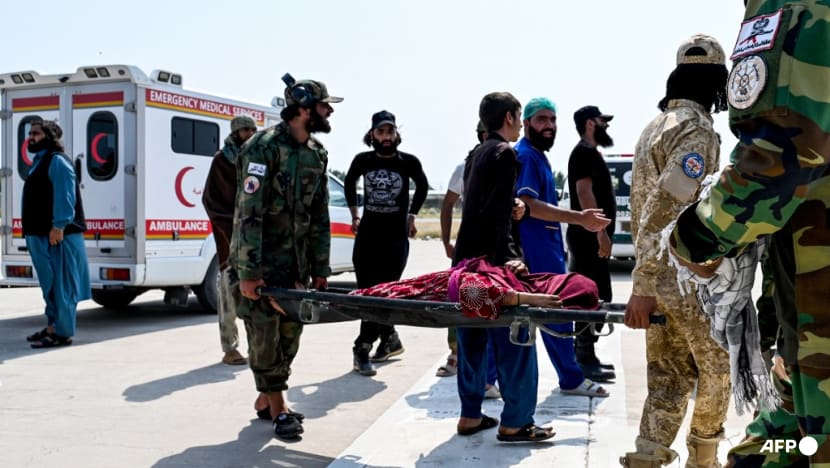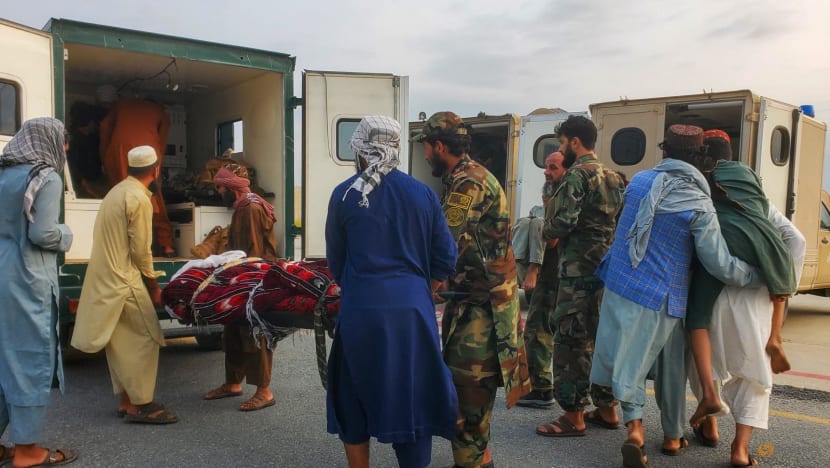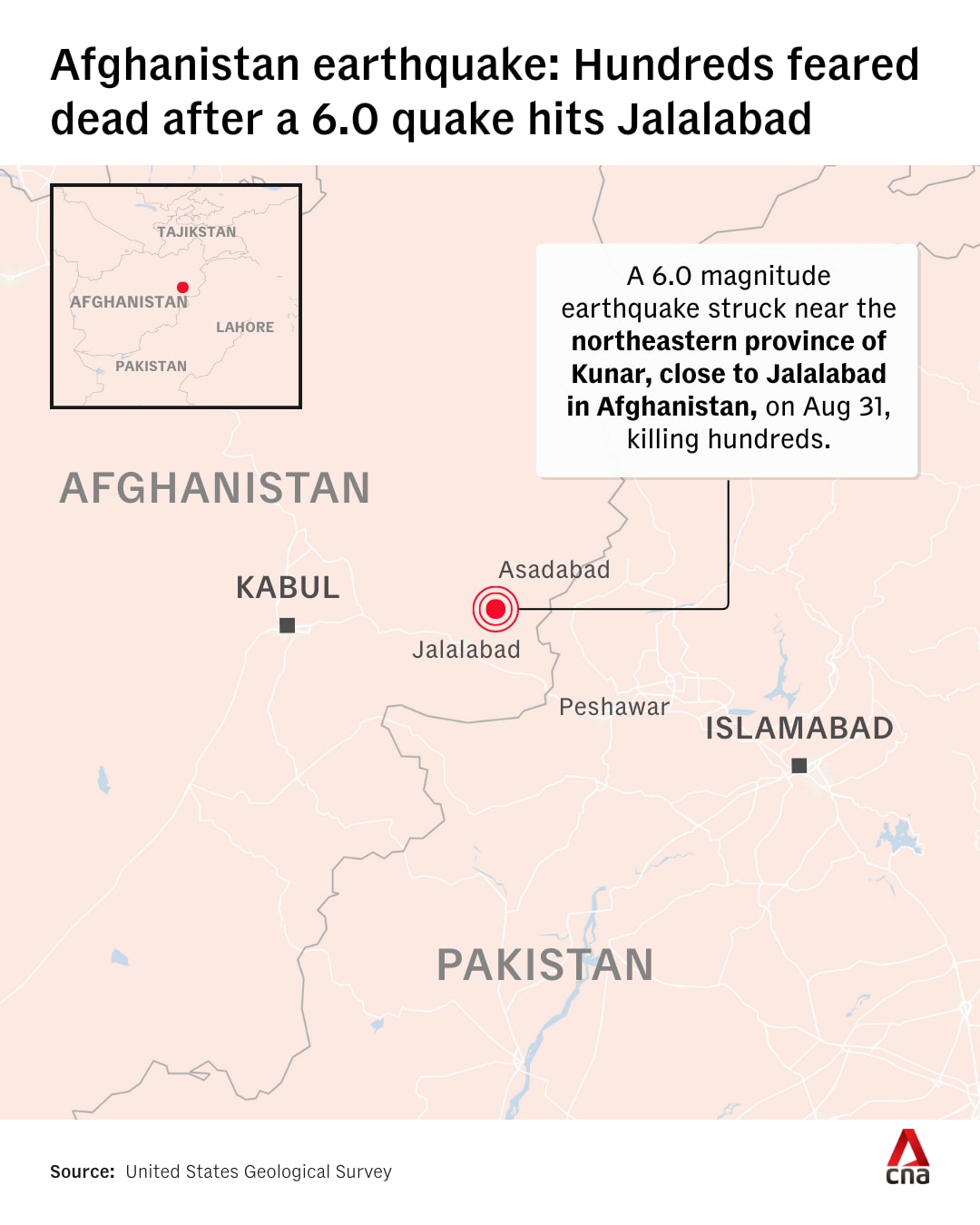Afghanistan earthquake kills more than 800, flattens villages

Afghan volunteers and Taliban security personnel carry an earthquake victim evacuated by a military helicopter from the Nurgal district of Kunar province, after his arrival for medical assistance in Jalalabad on Sep 1, 2025. (Photo: AFP/Wakil Kohsar)
NURGAL: A massive rescue operation was underway in Afghanistan on Monday (Sep 1), after a strong earthquake collapsed homes onto sleeping families in a remote, mountainous region, killing more than 800 people with the toll expected to rise, Taliban authorities said.
The 6.0-magnitude earthquake struck just before midnight, rattling buildings from Kabul to neighbouring Pakistan's capital Islamabad.
Casualties and destruction swept across at least five provinces and rescuers were still pulling people from destroyed homes and evacuating the injured by helicopter as evening approached.
"The search operation is still going on. Many people are stuck under the rubble of their roofs," the disaster management head in eastern Kunar province, Ehsanullah Ehsan, told AFP, warning the death toll could rise.
Around 800 people were killed and 2,500 injured in Kunar alone, near the epicentre, Taliban government spokesman Zabihullah Mujahid said.
Another 12 people were killed and 255 injured in neighbouring Nangarhar province, while 58 people were injured in Laghman province.
In Wadir village in Kunar's Nurgal district, dozens of residents of the surrounding area helped rescuers to pull people from the rubble of flattened homes, sometimes with their bare hands, AFP journalists saw.
Many injured were transported to hospitals in Jalalabad city in Nangarhar province, such as 22-year-old Zafar Khan Gojar, who was evacuated from Nurgal along with his brother whose leg was broken.
"The rooms and walls collapsed ... killing some children and injuring others," he told AFP.
The earthquake epicentre was about 27km from Jalalabad, according to the USGS, which said it struck about eight kilometres below the Earth's surface.

"FEAR AND TENSION"
Relatively shallow quakes can cause more damage, especially since the majority of Afghans live in low-rise, mud-brick homes vulnerable to collapse.
Some of the most severely impacted villages in Kunar "remain inaccessible due to road blockages", the UN migration agency warned in a statement to AFP.
Roads remained blocked nearly 20 hours after the earthquake, despite resident efforts to clear the way.
"There is a lot of fear and tension ... Children and women were screaming. We had never experienced anything like this in our lives," a member of the agricultural department in Nurgal Ijaz Ulhaq Yaad told AFP.
He said that many living in quake-hit villages were among the more than four million Afghans who have returned to the country from Iran and Pakistan in recent years.
"They wanted to build their homes here."
Nangarhar and Kunar provinces border Pakistan, with the Torkham crossing the site of many waves of Afghan returnees deported or forced to leave, often with no work and nowhere to go.
UN chief Antonio Guterres added his condolences to those shared by the Taliban government and several nations.
"I stand in full solidarity with the people of Afghanistan after the devastating earthquake that hit the country earlier today," he said.
In a post shared by the Vatican, Pope Leo XIV said he was "deeply saddened by the significant loss of life caused by the earthquake in the area of eastern Afghanistan".

FREQUENT QUAKES
Afghanistan is frequently hit by earthquakes, especially in the Hindu Kush mountain range, near the junction of the Eurasia and India tectonic plates.
Since 1900, there have been 12 earthquakes with magnitudes greater than seven in northeast Afghanistan, according to Brian Baptie, a seismologist at the British Geological Survey.
"This scale of the seismic activity, the potential for multi-hazard events and the construction of structures in the region can combine to create significant loss of life in such events," he said.
In October 2023, western Herat province was devastated by a 6.3-magnitude earthquake, which killed more than 1,500 people and damaged or destroyed more than 63,000 homes.
A 5.9-magnitude quake struck the eastern province of Paktika in June 2022, killing more than 1,000 people and leaving tens of thousands homeless.
Ravaged by four decades of war, Afghanistan is already contending with a series of humanitarian crises.
Since the return of the Taliban in 2021, foreign aid to Afghanistan has been slashed, undermining the impoverished nation's already hamstrung ability to respond to disasters.
Around 85 per cent of the Afghan population lives on less than one dollar a day, according to the UN Development Programme.
Joy Singhal, acting head of delegation for Afghanistan at the International Federation of Red Cross and Red Crescent Societies (IFRC), said while the country has endured repeated disasters, this latest quake struck an extremely mountainous region, making the impact particularly severe.
"It is very challenging to be able to reach those locations which are affected by the earthquake," he told CNA's Asia First on Tuesday.
"There have been recent landslides in the areas because of the earthquake. In the past few days, we have also seen massive rainfall. So search and rescue efforts are extremely difficult right now for us to be able to reach those areas which are affected and to rescue people out of the damaged homes," he added.
"On top of it, the country is facing a very massive malnutrition crisis, a food insecurity crisis, plus millions of Afghani nationals have been forced to return back from Pakistan and Iran in the past few months, which is compounding the crisis the country is facing at this point in time."
Singhal noted that several thousands of people had to spend last night in the open, adding: "We do not have enough tents that we have been able to dispatch to those areas, for people to be able to have some roof over their head to spend the night at.
"This could be the situation for the next few days as well, until the time we are able to provide humanitarian community support to all the people who need it."












